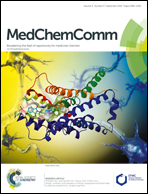Synthesis and biological evaluation of novel 5-chloro-N-(4-sulfamoylbenzyl) salicylamide derivatives as tubulin polymerization inhibitors
Abstract
A novel series of sulfonamide derivatives, coupled with a salicylamide scaffold, was designed and synthesized. The structures of the synthesized compounds were established using 1H NMR, 13C NMR and high-resolution mass spectroscopy. The synthesized compounds were tested in vitro against five types of human cell lines. Two were breast adenocarcinoma, including the hormone-dependent MCF-7 and the hormone-independent MDA-MB-231. The others were the colorectal adenocarcinoma Caco-2, the carcinoma HCT-116 and the immortalized retinal-pigmented epithelium, hTERT-RPE1. Nine sulfonamides were able to inhibit the growth of the four tested cancer cells. Compound 33 was the most active against the selected colon cancer (Caco-2 and HCT-116) subtypes, while compound 24 showed the best efficacy against the examined breast cancer (MCF-7 and MDA-MB-231) cells. The selectivity index introduced compounds 24 and 33 as having the best selectivity among the breast and colon subtypes, respectively. In vitro tubulin polymerization experiments and flow cytometric assays showed that compounds 24 and 33 led to cell cycle arrest at the G2/M phase in a dose-dependent manner by effectively inhibiting tubulin polymerization. Furthermore, the results of the molecular docking studies indicate that this class of compounds can bind to the colchicine-binding site of tubulin.



 Please wait while we load your content...
Please wait while we load your content...